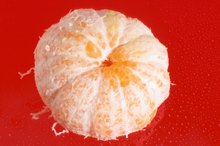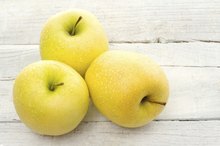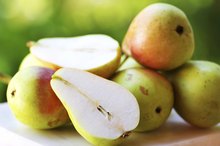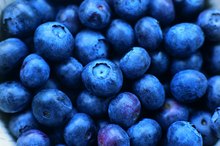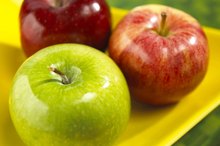Which Apples Relieve Heartburn?
The law of gravity dictates that what goes down should not come back up. This is especially true for burning stomach acids that cause uncomfortable heartburn by bouncing back into the esophagus uninvited. Heartburn can indicate an imbalance in the body between acidity and alkalinity, collectively known as pH. Sweet apples are considered alkaline foods that work at a cellular level to restore pH balance and prevent GERD -- Gastroesophageal Reflux Disease -- that stems from an untreated pH imbalance.
Red Delicious
The sweet and alkalizing nature of red delicious apples may be a gentler approach to stifling burning stomach acids and restoring pH balance. Over-the-counter antacids often interfere with the body’s ability to absorb the nutrients that prevent acid build-up in the stomach, notes Dr. Susan Brown in her book "The Acid-Alkaline Food Guide." Red delicious apples grow in zones 5 to 8, and are harvested in September and October 2.
Granny Smith
Stomach Burns After Eating Oranges
Learn More
Consuming a sweet and tart Granny Smith apple at room temperature right before eating can help to extinguish the burn of acid reflux before it begins. Dr. Brown says that heartburn is often a sign of low hydrochloric stomach acids and enzymes, resulting in partially digested food. Granny Smith apples can help to resolve such problems. Granny Smith apples grow in zones 6 through 8. Newly planted trees usually yield fruit after four to five years.
- Consuming a sweet and tart Granny Smith apple at room temperature right before eating can help to extinguish the burn of acid reflux before it begins.
- Dr. Brown says that heartburn is often a sign of low hydrochloric stomach acids and enzymes, resulting in partially digested food.
Braeburn
As an alkalizing food, the sweet and spicy Braeburn apple increases the absorption of nutrients and oxygen in body cells and removes stored waste that contributes to pH imbalances. Braeburn apples grow in zones 4 through 10, with harvesting and nationwide distribution in early October. These apples are a more recent cultivar, having been discovered in New Zealand in the 1952.
Related Articles
References
- Medical News Today: Alkaline Diet Can Combat the Effects of Acid Reflux
- “The Acid-Alkaline Food Guide”; Susan Brown, PhD; 2006
- “The Backyard Orchardist: A Complete Guide to Growing Fruit Trees in the Home Garden”; Stella Otto; 1995
- University of Illinois Extension: Apples and More: Varieties
- Apple, raw. FoodData Central. U.S. Department of Agriculture. Updated April 1, 2020.
- Glycemic index for 60+ foods. Harvard Medical School Harvard Health Publishing. Updated January 6, 2020.
- Koutsos A, Tuohy KM, Lovegrove JA. Apples and cardiovascular health--is the gut microbiota a core consideration?. Nutrients. 2015;7(6):3959‐3998. doi:10.3390/nu7063959
- Improving your health with fiber. Cleveland Clinic. Updated April 15, 2019.
- Gibellini L, Pinti M, Nasi M, et al. Quercetin and cancer chemoprevention. Evid Based Complement Alternat Med. 2011;2011:591356. doi:10.1093/ecam/neq053
- Mlcek J, Jurikova T, Skrovankova S, Sochor J. Quercetin and its anti-allergic immune response. Molecules. 2016;21(5). doi:10.3390/molecules21050623
- Flood-Obbagy JE, Rolls BJ. The effect of fruit in different forms on energy intake and satiety at a meal. Appetite. 2009;52(2):416‐422. doi:10.1016/j.appet.2008.12.001
- Wagner A, Szwed A, Buczyłko K, Wagner W. Allergy to apple cultivars among patients with birch pollinosis and oral allergy syndrome. Ann Allergy Asthma Immunol. 2016;117(4):399-404. doi:10.1016/j.anai.2016.08.015
- Carlson G, Coop C. Pollen food allergy syndrome (PFAS): A review of current available literature. Ann Allergy Asthma Immunol. 2019;123(4):359-365. doi.10.1016/j.anai.2019.07.022
- Vally H, Misso NL. Adverse reactions to the sulphite additives. Gastroenterol Hepatol Bed Bench. 2012;5(1):16‐23.
- The best and worst foods for IBS. Cleveland Clinic. Updated December 4, 2019.
Writer Bio
Based near America's "Gateway to the West," Li St. Michael has been writing professionally since 2005. Her culturally minded articles have appeared on various websites. St. Michael holds a Bachelor of Science in writing from Drury University and is set to receive a Masters degree in international relations in 2011.
